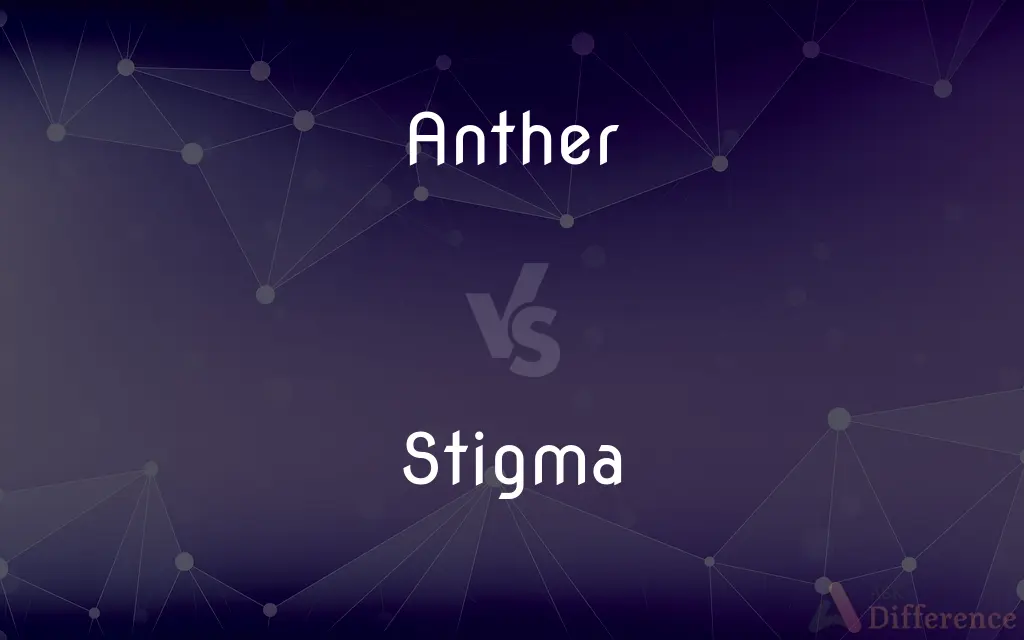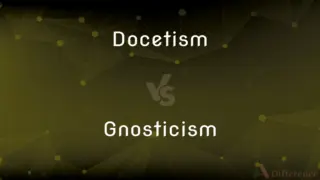Anther vs. Stigma — What's the Difference?
By Tayyaba Rehman — Updated on September 21, 2023
Anther is the part of a flower's stamen that produces pollen, while Stigma is the receptive tip of a flower's pistil where pollen germinates.

Difference Between Anther and Stigma
Table of Contents
ADVERTISEMENT
Key Differences
Anther and Stigma are integral components of flowering plants, each playing a pivotal role in the process of reproduction. The Anther is part of the stamen, which is the male reproductive organ of a flower. It is responsible for producing and storing pollen, the powdery substance that carries male gametes.
Stigma, on the other hand, is situated at the top of the pistil, the female reproductive organ of a flower. Its primary function is to receive the pollen that comes from the Anther. The Stigma's surface is often sticky or feathery, facilitating the capture of pollen grains and enabling the process of fertilization.
It's noteworthy to mention the interdependence of the Anther and Stigma during the reproduction cycle. For a flower to reproduce, pollen from an Anther must reach the Stigma of the same species. Once the pollen grain lands on the Stigma, it starts the process of germination, which ultimately leads to the production of seeds.
In the grand scheme of plant reproduction, both Anther and Stigma are crucial. While the Anther ensures the creation and release of pollen, the Stigma is the site where the pollen's journey begins, aiming for successful fertilization.
Comparison Chart
Part of
Stamen (male part).
Pistil (female part).
ADVERTISEMENT
Function
Produces and stores pollen.
Receives and germinates pollen.
Appearance
Typically a lobe or sac-like structure.
Sticky or feathery tip.
Role in Reproduction
Distributor of male gametes.
Receptor for pollen and initiator of germination.
Relation to Pollination
Source of pollen.
Destination for pollen.
Compare with Definitions
Anther
The pollen-producing part of a flower's stamen.
The Anther releases pollen when the flower is mature.
Stigma
The receptive part of the pistil in flowering plants.
The bee transferred pollen grains to the flower's Stigma.
Anther
Essential for plant fertilization.
Without the Anther, the plant would be unable to produce seeds.
Stigma
Where the process of pollen germination begins.
Once the pollen landed on the Stigma, fertilization commenced.
Anther
Source of genetic diversity in plant reproduction.
Cross-pollination occurs when pollen from one Anther fertilizes another plant's Stigma.
Stigma
Can be single or have multiple lobes depending on the species.
The flower had a tri-lobed Stigma, giving it a unique appearance.
Anther
Often appears as a yellowish bulb on a thin filament.
The lily's Anther stood out with its bright yellow hue.
Stigma
Often sticky or feathery in texture.
The Stigma's sticky surface ensures the pollen remains attached.
Anther
A sac-like structure holding male gametes in flowering plants.
When the wind blew, it dispersed the pollen grains from the Anther.
Stigma
Crucial for successful plant reproduction.
If the Stigma doesn't capture pollen, the plant won't produce seeds.
Anther
The pollen-bearing part of a stamen.
Stigma
An association of disgrace or public disapproval with something, such as an action or condition
"Depression ... has become easier to diagnose, and seeking treatment does not carry the stigma it once did" (Greg Critser).
Anther
(botany) The pollen-bearing part of the stamen of a flower.
Stigma
A visible indicator of disease.
Anther
That part of the stamen containing the pollen, or fertilizing dust, which, when mature, is emitted for the impregnation of the ovary.
Stigma
A small bodily mark, especially a birthmark or scar, that is congenital or indicative of a condition or disease.
Anther
The part of the stamen that contains pollen; usually borne on a stalk
Stigma
(Psychology) A bleeding spot on the skin considered to be a manifestation of conversion disorder.
Stigma
Stigmata(Christianity) Bodily marks, sores, or sensations of pain corresponding in location to the crucifixion wounds of Jesus, believed to be given as divine recognition of devotion.
Stigma
(Botany) The apex of the pistil of a flower, on which pollen grains are deposited and germinate.
Stigma
(Biology) A small mark, spot, or pore, such as the respiratory spiracle of an insect or an eyespot in certain protists.
Stigma
(Archaic) A mark burned into the skin as a visible identifier of a person as a criminal or slave; a brand.
Stigma
A mark of infamy or disgrace.
Stigma
A scar or birthmark.
Stigma
A mark on the body corresponding to one of the wounds of the Crucifixion on Jesus' body, and sometimes reported to bleed periodically.
Stigma
An outward sign; an indication.
Stigma
(botany) The sticky part of a flower that receives pollen during pollination.
Stigma
(medicine) A visible sign or characteristic of a disease.
Stigma
(typography) A ligature of the Greek letters sigma and tau, (Ϛ/ϛ).
Stigma
A mark made with a burning iron; a brand.
Stigma
Any mark of infamy or disgrace; sign of moral blemish; stain or reproach caused by dishonorable conduct; reproachful characterization.
The blackest stigma that can be fastened upon him.
All such slaughters were from thence called Bartelmies, simply in a perpetual stigma of that butchery.
Stigma
That part of a pistil which has no epidermis, and is fitted to receive the pollen. It is usually the terminal portion, and is commonly somewhat glutinous or viscid. See Illust. of Stamen and of Flower.
Stigma
A small spot, mark, scar, or a minute hole; - applied especially to a spot on the outer surface of a Graafian follicle, and to spots of intercellular substance in scaly epithelium, or to minute holes in such spots.
Stigma
A red speck upon the skin, produced either by the extravasation of blood, as in the bloody sweat characteristic of certain varieties of religious ecstasy, or by capillary congestion, as in the case of drunkards.
Stigma
One of the external openings of the tracheæ of insects, myriapods, and other arthropods; a spiracle.
Stigma
A point so connected by any law whatever with another point, called an index, that as the index moves in any manner in a plane the first point or stigma moves in a determinate way in the same plane.
Stigma
Marks believed to have been supernaturally impressed upon the bodies of certain persons in imitation of the wounds on the crucified body of Christ. See def. 5, above.
Stigma
The apical end of the style where deposited pollen enters the pistil
Stigma
A symbol of disgrace or infamy;
And the Lord set a mark upon Cain
Stigma
An external tracheal aperture in a terrestrial arthropod
Stigma
A skin lesion that is a diagnostic sign of some disease
Common Curiosities
What is the primary function of the Anther?
The Anther produces and stores pollen in flowering plants.
Can a flower have multiple Anthers?
Yes, many flowers have multiple stamens, each with its Anther.
Does every flower have both an Anther and a Stigma?
Most flowers have both, but some are male or female only, containing either Anthers or Stigmas, respectively.
How does the pollen get from the Anther to the Stigma?
Pollen can be transferred by wind, water, animals, or insects.
Why is the Stigma often sticky?
The Stigma is sticky to effectively capture and hold pollen grains.
Where is the Stigma located in a flower?
The Stigma is located at the top of the pistil, the female reproductive organ.
Share Your Discovery

Previous Comparison
Brawl vs. Fight
Next Comparison
Docetism vs. GnosticismAuthor Spotlight
Written by
Tayyaba RehmanTayyaba Rehman is a distinguished writer, currently serving as a primary contributor to askdifference.com. As a researcher in semantics and etymology, Tayyaba's passion for the complexity of languages and their distinctions has found a perfect home on the platform. Tayyaba delves into the intricacies of language, distinguishing between commonly confused words and phrases, thereby providing clarity for readers worldwide.















































